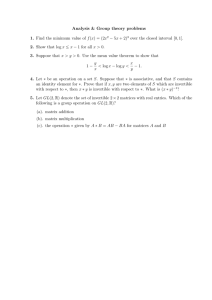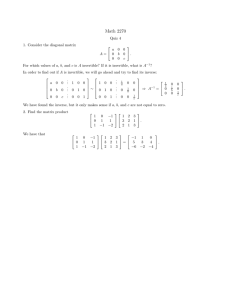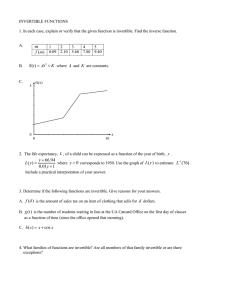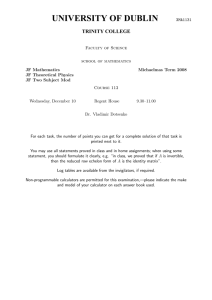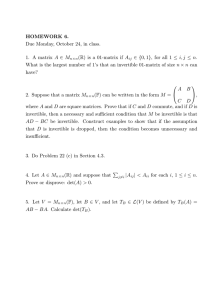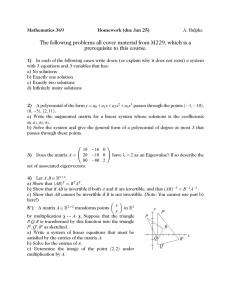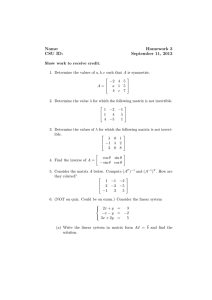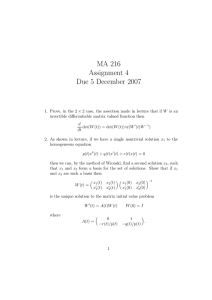16 Homogeneous Systems Any system of linear equations can be
advertisement
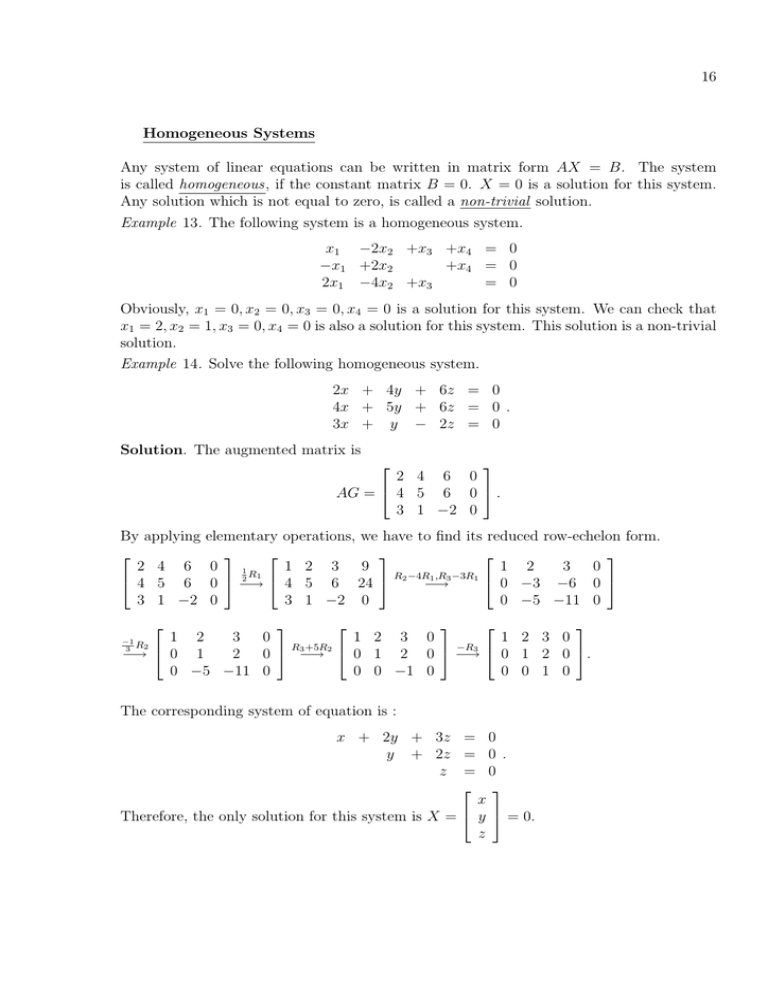
16 Homogeneous Systems Any system of linear equations can be written in matrix form AX = B. The system is called homogeneous, if the constant matrix B = 0. X = 0 is a solution for this system. Any solution which is not equal to zero, is called a non-trivial solution. Example 13. The following system is a homogeneous system. x1 −2x2 +x3 +x4 = 0 −x1 +2x2 +x4 = 0 2x1 −4x2 +x3 = 0 Obviously, x1 = 0, x2 = 0, x3 = 0, x4 = 0 is a solution for this system. We can check that x1 = 2, x2 = 1, x3 = 0, x4 = 0 is also a solution for this system. This solution is a non-trivial solution. Example 14. Solve the following homogeneous system. 2x + 4y + 6z = 0 4x + 5y + 6z = 0 . 3x + y − 2z = 0 Solution. The augmented matrix is 2 4 6 0 AG = 4 5 6 0 . 3 1 −2 0 By applying 2 4 6 4 5 6 3 1 −2 elementary 0 1 R 2 1 0 −→ 0 operations, we have to find its reduced row-echelon form. 1 2 3 9 1 2 3 0 R2 −4R1 ,R3 −3R1 0 −3 −6 0 4 5 6 24 −→ 3 1 −2 0 0 −5 −11 0 1 2 3 0 1 2 3 0 1 2 3 0 R3 +5R2 −R3 0 1 2 0 −→ 0 1 2 0 . 2 0 −→ −→ 0 1 0 −5 −11 0 0 0 −1 0 0 0 1 0 −1 R2 3 The corresponding system of equation is : x + 2y + 3z = 0 y + 2z = 0 . z = 0 x Therefore, the only solution for this system is X = y = 0. z 17 Remark 6. There are two possibilities for the set of solutions for a homogeneous system. 1. Unique solution X = 0 2. Infinitely many solutions Basic Solutions Consider the homogeneous system AX = 0. If this system has a nontrivial solutions, then by Gaussian elimination we can find non-trivial solutions X1 , · · · , Xk such that any other solution of the system is in the form t1 X1 + t2 X2 + · · · + tk Xk , where t1 , · · · , tk are numbers. X1 , · · · , Xk are called basic solutions for the system and a solution of the form t1 X1 + t2 X2 + · · · + tk Xk is called a linear combination of X1 , · · · , Xk . Example 15. Solve the following homogeneous system of linear equations. x + 2y + −z = 0 3x + −3y + 2z = 0 . −x + −11y + 6z = 0 Solution. The augmented matrix is 1 2 −1 0 AG = 3 −3 2 0 . −1 −11 6 0 By applying elementary operations, we have to find its reduced row-echelon form. 1 2 −1 0 1 2 −1 0 R +R , −1 R 1 2 −1 0 2 9 2 1 ,R3 +R1 3 −3 2 0 R2 −3R 0 −9 5 0 3 −→ 0 1 −5 0 −→ 9 −1 −11 6 0 0 −9 5 0 0 0 0 0 1 0 19 0 R1 −2R2 0 . −→ 0 1 −5 9 0 0 0 0 The corresponding system of equation is : x + + y + 1 z 9 −5 z 9 = 0 . = 0 Take z = t. Therefore, the solutions are in the form −1 −1 x t 9 9 X = y = 59 t = t 59 . z t 1 18 Here, X1 = −1 9 5 9 1 is the basic solution. Example 16. Find the basic solutions for the following homogeneous system. x1 −2x1 3x1 2x1 −2x2 +4x3 −x4 +5x6 +4x2 −7x3 +x4 +2x5 −8x6 −6x2 +12x3 −3x4 +x5 +15x6 −4x2 +9x3 −3x4 +3x5 +12x6 Solutions: 1 −2 4 −1 0 5 0 −2 4 −7 1 2 −8 0 3 −6 12 −3 1 15 0 2 −4 9 −3 3 12 0 = = = = 0 0 0 0 R2 +2R1 ,R3 −3R1 ,R3 −2R1 −→ 1 −2 4 −1 0 5 0 0 0 1 −1 2 2 0 R4 −2R2 3 ,R1 −4R2 R4 −2R−→ −→ 0 0 0 0 1 0 0 0 0 0 0 0 2 0 1 −2 4 −1 0 0 1 −1 0 0 0 0 0 0 1 −1 0 2 1 3 5 2 0 2 0 0 0 0 1 −2 0 3 −8 −3 0 0 0 1 −1 2 2 0 0 0 0 0 1 0 0 0 0 0 0 0 0 0 1 −2 0 3 0 −3 0 0 0 1 −1 0 2 0 0 0 0 0 1 0 0 0 0 0 0 0 0 0 R1 +8R3 ,R2 −2R3 −→ Assign non-leading variables as parameters. Then, x2 = t, x4 = s, x6 = u, x5 = 0, x3 = t − 2u, x1 = 2t − 3s + 3u. The solutions are: X= x1 x2 x3 x4 x5 x6 = 2t − 3s + 3u t s − 2u s 0 u = 2t t 0 0 0 0 + −3s 0 s s 0 0 + 3u 0 −2u 0 0 u = 19 −3 3 0 0 1 −2 t + s 1 + u 0 . 0 0 0 1 2 −3 3 0 0 1 1 −2 0 Therefore, the basic solutions are X1 = , X2 = , X2 = 0 . 0 1 0 0 0 0 0 1 2 1 0 0 0 0 Remark 7. Consider a homogeneous system of linear equation with n variables. If the augmented matrix of the system has rank r, then solutions consist of n − r parameters. Thus, we can express any solution as a linear combination of n − r basic solutions. Consider the linear system AX = B. The linear system AX = 0 is called the associated homogeneous system for the system AX = B. Let Y be a solution for the homogeneous system and X0 be a particular solution for the system AX = B. Then, since A(X0 + Y ) = AX0 + AY = B + 0 = B (X0 + Y ) also is a solution for the system. Conversely, if Z be a solution for the system then A(Z − X0 ) = B − B = 0. Thus, Y = Z − X0 is a solution for the associated system. This shows any solution is in the form X0 + Y . Example 17. Example 18. Solve the following system of equations. x − y − z = 2 2x − y − 3z = 6 . x − 2z = 4 Solution. The augmented matrix is 1 −1 −1 2 AG = 2 −1 −3 6 . 1 0 −2 4 By applying elementary operations, we have to find its reduced row-echelon form. 20 1 −1 −1 2 1 −1 −1 2 1 −1 −1 2 1 ,R3 −R1 3 −R2 2 −1 −3 6 R2 −2R 0 1 −1 2 R−→ 0 1 −1 2 −→ 1 0 −2 4 0 1 −1 2 0 0 0 0 1 0 −2 4 R2 +R1 −→ 0 1 −1 2 . 0 0 0 0 The corresponding system of equation is : x − 2z = 4 y − z = 2 . 0 = 0 z is non-leading variable. Therefore, we assign it as a parameter. If z = t, then the solution has the parametric form x = 2t + 4 y = t+2 z = t. 4 In this example the particular solution is X = 2 and the general solution for the 0 2 associated homogeneous system is Y = t 1 . 1 Example 19. Express the solutions of the following system as the sum of particular solution and general solution of the associated homogeneous system. x1 −2x2 −x3 +3x4 = 1 2x1 −4x2 +x3 = 5 x1 −2x2 +2x3 −3x4 = 4 The augmented matrix is: 1 −2 −1 3 1 0 5 . AG = 2 −4 1 1 −2 2 −3 5 Apply elementary operations to get the row-echelon 1 −2 −1 3 1 1 −2 −1 R2 −2R1 ,R3 −R1 2 −4 1 0 0 0 5 3 −→ 1 −2 2 −3 5 0 0 3 form. 3 1 R −R , 1 R 1 −2 −1 3 1 3 2 2 −6 3 −→3 0 0 1 −2 1 −6 3 0 0 0 0 0 21 1 −2 0 R1 +R2 0 0 1 −→ 0 0 0 The corresponding 1 2 −2 1 . 0 0 system of equations is: x1 −2x2 +x4 = 2 x3 −2x4 = 1 0 = 0 Let x2 = t, x4 = s. Then, the set of solutions are: x1 2 + 2t − s 2 x2 t 0 X= x3 = 1 + 2s = 1 x4 s 0 2 −1 1 0 + t + s 0 2 0 1 . In this example the particular solution is: 2 0 1 0 The general solutions for the associated homogeneous system is: 2 −1 0 1 t 0 + s 2 0 1 . Matrix Inverses Let A be a square matrix of size n. A matrix B is called inverse of A if AB = BA = I. If A has an inverse, then we say that A is invertible. The inverse of A is unique and we denote it by A−1 . · ¸ · ¸ 1 1 1 −1 Example 20. Let A = . Then A−1 = . 0 1 0 1 ¸ · ¸ · a b d −b 1 −1 Example 21. If A = and ad − bc 6= 0 then A = ad−bc . c d −c a 22 1 4 −1 −3 −3 11 1 −3 . Example 22. A = 2 7 1 . Then, A−1 = 12 1 1 3 0 −1 1 −1 Theorem 6. If a square matrix A, has a zero row (zero column), then A is not invertible. Proof. Suppose that the i-th row of A is zero. For any square matrix C, the (i, i)-entry of AC is equal to dot product of the i-th row of A with i-th column of C. Therefore, (i, i)-entry of AC is 0. But, the (i, i)-entry of identity matrix is equal to 1. Thus, AC 6= I for any C. Therefore, A is not invertible. 1 12 13 3 0 0 0 0 Example 23. A = and B = 9 9 1 1 0 9 3 2 1 2 1 4 4 0 0 0 0 0 5 9 8 2 6 9 11 5 1 2 1 are not invertible. 1 1 7 7 Theorem 7. If A and B are square matrices, then • If A is invertible, then A−1 is invertible, and (A−1 )−1 = A. • If A and B are invertible, then AB is invertible, and(AB)−1 = B −1 A−1 . • If A is invertible, then AT is invertible, and(AT )−1 = (A−1 )T . • If A is invertible, then 1c A is invertible for a number c 6= 0, and (cA)−1 = 1c A−1 . Example 24. A,B, and C are invertible matrices. Simplify C T B(AB)−1 [C −1 AT ]T . Solution: C T B(AB)−1 [C −1 AT ]T = C T B(B −1 A−1 )[(AT )T (C −1 )T ] = C T IA−1 [A(C −1 )T ] = C T I(C −1 )T = I. Example 25. Find the matrix A. · ¸ £ ¤T −1 1 1 2 − 5A−1 = ( AT )−1 . −2 3 4 23 Solution: · 2 ¸T 1 1 −2 3 Thus, − 5(AT )−1 = −4(AT )−1 · 2 1 1 −2 3 Then, 1 A= 10 ¸T = (A−1 )T . · 3 −1 2 1 ¸ .
